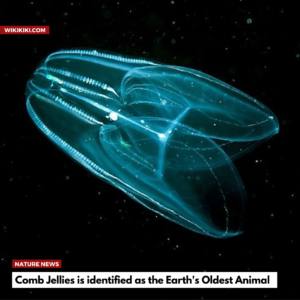Comb Jellies: Scientists have made significant discoveries regarding the Earth’s oldest known animal through a study published in the journal Nature. The research points to comb jellies, scientifically known as ctenophores, as the first animals to have roamed the planet approximately 700 million years ago. This finding challenges previous debates that revolved around whether sponges or comb jellies were the earliest animals.
By examining the organization of genes in chromosomes, researchers have shed light on the evolutionary history and relationships among animals, providing valuable insights into the basic functions and origins of all animals, including humans.
Also Read: New Dinosaur Species Reveals Clues about Spinosaurus History

Researchers from the University of California Berkeley conducted a study that examined the organization of genes in the chromosomes of various organisms. Through this analysis, they found distinct differences in the chromosome structure of comb jellies compared to sponges, jellyfish, and other invertebrates. These findings indicate that comb jellies may have diverged from the common ancestor before other animal lineages appeared.
Differentiating Comb Jellies from Jellyfish
Despite their name, comb jellies are not closely related to jellyfish. They possess oval-shaped bodies and use cilia, not tentacles, to propel themselves through water. Comb jellies are still present in marine ecosystems worldwide, showcasing their resilience over millions of years.
Also Read: Italy’s Worst Flooding in 100 Years, Atleast 15,000 People Displaced
Decoding the Ancient Past
Determining the identity of the earliest animal poses challenges due to the lack of a direct fossil record. Soft-bodied organisms, like the comb jelly, do not leave behind well-preserved fossils. However, by comparing the genetic characteristics of living animals, scientists can gain insights into our common ancestors. This comparative approach allows researchers to estimate that the most recent common ancestor of all animals lived between 600 and 700 million years ago.
Debating the First Animal
For years, the scientific community has debated whether the first animal to emerge was a comb jelly or a sponge. Sponges, characterized by their stationary lifestyle and filtration feeding, were previously considered the more primitive organism. However, the recent study suggests that while sponges appeared early in evolutionary history, they were likely preceded by comb jellies.
Chromosome Analysis Reveals Clues
To determine the evolutionary relationship between ctenophores, sponges, and other animals, scientists examined the structure of chromosomes in these organisms. The distinct differences in chromosome organization between ctenophores and other animals, such as sponges and jellyfish, provided crucial evidence. By comparing these structures to non-animal species, researchers found gene-chromosome combinations shared by ctenophores and non-animals, indicating an early branching off from the common ancestor.
Also Read: Why Physically Fit People Experience Heart Attacks?
Implications for Animal Evolution
This groundbreaking research not only sheds light on the first animal to have roamed the Earth but also has broader implications for understanding the evolution of animals, including humans. The knowledge gained from studying comb jellies can help scientists better understand fundamental functions common to all animals, such as feeding, movement, and sensory perception. Moreover, this discovery challenges the timeline of the evolution of neuron-like cells, pushing it back by approximately 100 million years.
Continuing the Debate
While this study presents compelling evidence for the comb jelly’s status as Earth’s oldest animal, some researchers remain cautious and emphasize the need for multiple sources of robust data to fully convince the scientific community. The study’s findings have certainly shifted the debate, but the complex nature of unraveling ancient evolutionary history requires further exploration and research.
By investigating the genetic and chromosomal characteristics of ancient organisms like comb jellies, scientists can reconstruct the evolutionary history of animals. This research pushes back the timeline for the development of neuron-like cells by approximately 100 million years and challenges long-held assumptions about the origins of animal life.
Conclusion
The latest research suggests that comb jellies, or ctenophores, were the first animals to roam the Earth around 700 million years ago. Their distinct genetic and chromosomal characteristics set them apart from sponges and other animals, pointing to their early divergence from the common ancestor. These findings enhance our understanding of animal evolution and provide valuable insights into the origins of various animal species, including humans. Further studies on ancient organisms will continue to shape our knowledge of the early history of life on Earth.
Also Read: How to Overcome Social Anxiety Fast and Become Confident

















+ There are no comments
Add yours